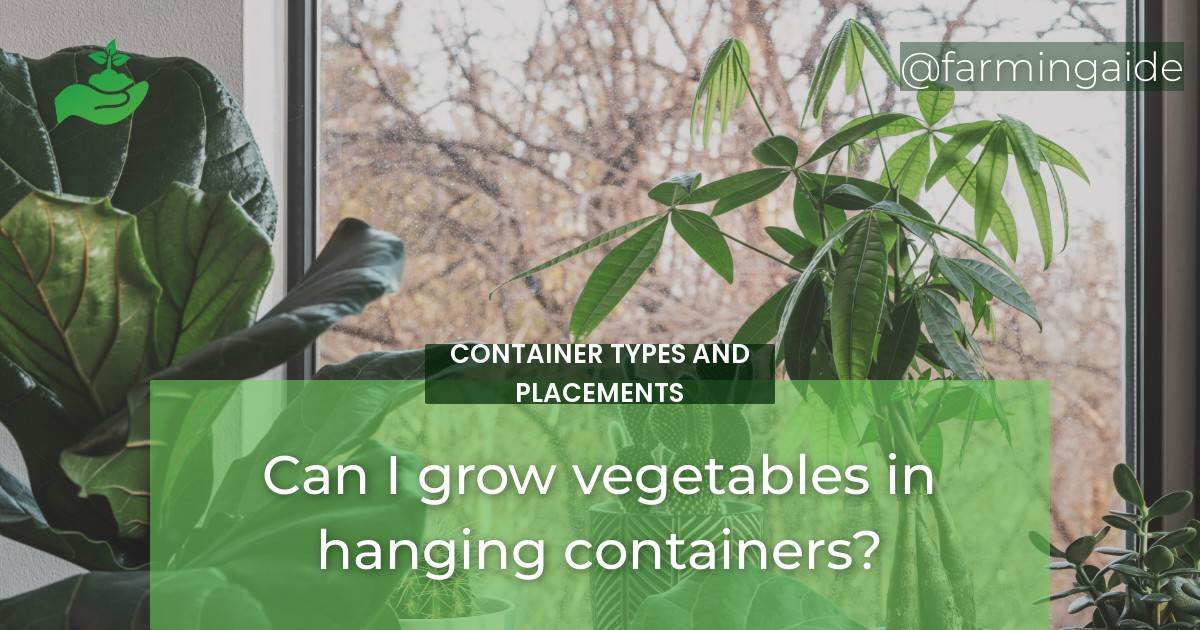Yes, you can grow vegetables in hanging containers. This is an excellent option for people with limited space or those looking for an easy and convenient way to grow their vegetables. Growing vegetables in hanging containers can not only save space, but it can also prevent pests and diseases that can arise from growing vegetables in the ground. In this article, we will dive deep into the benefits of growing vegetables in hanging containers, the types of vegetables that can be grown, choosing the right container, soil and fertilizer requirements, watering and sunlight requirements, best practices, and considerations for container placement.
Benefits of Growing Vegetables in Hanging Containers
One of the significant benefits of growing vegetables in hanging containers is that it saves space. Hanging containers can be hung from railings, walls, and ceilings, which makes them ideal for small balconies and patios. Moreover, since hanging containers are off the ground, they are less likely to be affected by pests and diseases. This can reduce the need for pesticides and herbicides, making your vegetables healthier and safer to eat. Additionally, hanging containers are easy to maintain and can be moved around as needed, making them ideal for gardeners with limited mobility.
Types of Vegetables that Can Be Grown in Hanging Containers
Many types of vegetables can be grown in hanging containers, including tomatoes, peppers, lettuce, and herbs. These vegetables have shallow root systems and do not require a lot of soil depth, making them suitable for hanging containers. In addition to these vegetables, you can also grow strawberries, cucumbers, and other small fruits and vegetables, as long as you choose the right container and provide the necessary care.
ALSO READ
Choosing the Right Container
Choosing the right container is essential for growing vegetables in hanging containers. When choosing a container, consider the size, material, and drainage. The container should be large enough to accommodate the root system of your chosen vegetables, but not so large that it becomes too heavy to hang. Plastic, fabric, and metal containers are all suitable materials for hanging containers, but plastic may be the best choice because it is lightweight and inexpensive. Additionally, the container should have adequate drainage to prevent overwatering and root rot.
Soil and Fertilizer Requirements
The soil you choose for your hanging container is critical for the growth and success of your vegetables. Choose a high-quality potting mix that is rich in nutrients and has good drainage. Additionally, you should fertilize your vegetables regularly to ensure they have the necessary nutrients to grow and thrive. Use a balanced fertilizer that contains equal parts nitrogen, phosphorus, and potassium, and follow the instructions on the package for application.
ALSO READ
Watering and Sunlight Requirements
Watering and sunlight are two critical factors in the growth and success of vegetables in hanging containers. Water your vegetables regularly, but be careful not to overwater them. The container should have good drainage to prevent waterlogging, and you can use a moisture meter to determine when your vegetables need water. Additionally, make sure your vegetables receive adequate sunlight. Most vegetables require at least 6 hours of direct sunlight per day, so choose a location for your hanging container that receives adequate sunlight.
Best Practices for Growing Vegetables in Hanging Containers
Proper planting techniques, spacing, pruning, and training are essential for growing vegetables in hanging containers. When planting your vegetables, make sure you plant them at the appropriate depth and spacing, and prune them regularly to promote healthy growth. Additionally, you can train your vegetables to grow in a particular direction, which can help maximize space and sunlight.
Considerations for Container Placement
When choosing a location for your hanging container, consider weight, wind, and sun exposure. Make sure the location can support the weight of the container and the soil, and choose a location that is protected from strong winds. Additionally, make sure your vegetables receive adequate sunlight to grow and thrive.
Conclusion
Growing vegetables in hanging containers is an excellent option for people with limited space or those looking for an easy and convenient way to grow their vegetables. To be successful in growing vegetables in hanging containers, you must choose the right container, soil, and fertilizer, and provide your vegetables with adequate water and sunlight. Additionally, proper planting techniques, spacing, pruning, and training are essential for healthy growth. By following these tips and best practices, you can grow delicious and healthy vegetables in hanging containers.
RELATED ARTICLES:


